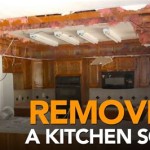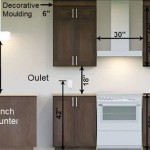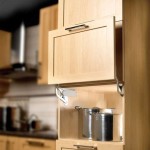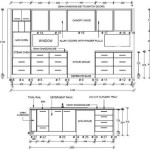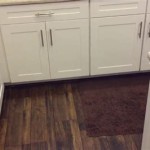How to Fix a Kitchen Cabinet Falling Off the Wall
A kitchen cabinet falling off the wall can be a frustrating experience. It can be a safety hazard and disrupt your kitchen's functionality. Fortunately, fixing a loose cabinet is often a simple DIY project. This article will guide you through the steps necessary to secure your kitchen cabinet and prevent it from falling again.
Assess the Damage and Determine the Cause
The first step is to understand why the cabinet is falling. This will determine the appropriate repair method. Carefully examine the cabinet and the wall for the following:
- Loose screws or nails: The most common cause of a falling cabinet is loose fasteners. Check if the screws or nails holding the cabinet to the wall are loose or missing.
- Damaged drywall: If the drywall behind the cabinet is damaged, it may not be able to support the cabinet's weight. Look for cracks, holes, or crumbling drywall.
- Improper installation: Cabinets may fall if they were not installed correctly in the first place. Check the cabinet's mounting method and ensure it is secure.
- Overloaded cabinet: A cabinet overloaded with heavy items can put excessive strain on its mounting system. Consider redistributing the weight or removing some items.
It is important to note that if the cabinet is very heavy or the damage is extensive, professional help may be needed.
Repairing Loose Fasteners
If the problem is loose screws or nails, you can usually fix it yourself. Here's what you'll need:
- Screwdriver or drill
- New screws or nails (if necessary)
- Level
- Wood filler (optional)
- Paint or wood stain (optional)
Follow these steps:
- Empty the cabinet: Remove all items from the cabinet to reduce its weight and make it easier to work with.
- Tighten loose fasteners: Use a screwdriver or drill to tighten any loose screws or nails. If the fasteners are stripped or damaged, replace them with new ones.
- Check for additional support: If the cabinet is still loose, consider adding more screws or nails for additional support. Make sure the new fasteners are placed in solid wood, not drywall alone.
- Fill holes: If any holes are left from removing old fasteners, fill them with wood filler. Let the filler dry completely before painting or staining.
- Reattach the cabinet: Once the fasteners are secure and the filler is dry, carefully reattach the cabinet to the wall. Use a level to ensure that the cabinet is straight.
Addressing Damaged Drywall
If the drywall behind the cabinet is damaged, you will need to repair it before securing the cabinet. This involves patching the drywall and ensuring a solid surface for the cabinet mounting. Here's what you'll need:
- Drywall patch kit (including drywall patch, mesh tape, and joint compound)
- Putty knife
- Sandpaper
- Primer
- Paint (matching the existing wall color)
Follow these steps:
- Remove damaged drywall: Carefully cut out the damaged area of drywall using a utility knife. Make sure the edges are clean and straight.
- Install the drywall patch: Apply adhesive to the back of the drywall patch and press it firmly into the hole. Use screws to secure the patch to the wall studs for added support.
- Apply joint compound: Use a putty knife to apply a thin layer of joint compound over the patch, smoothing it out to match the surrounding wall. Let the compound dry completely.
- Sand and prime: Once the compound is dry, sand the surface to smooth out any imperfections. Prime the patched area before painting.
- Paint the patched area: Apply paint to the patched area to match the existing wall color.
- Secure the cabinet: After the paint has thoroughly dried, reattach the cabinet to the wall using new screws.
Reinforcing the Cabinet Mounting
If the cabinet was not installed correctly or needs additional support, you can reinforce its mounting by adding more screws or using stronger mounting hardware. Here's what you'll need:
- Heavy-duty screws or lag bolts
- Drill with a drill bit matching the screw size
- Level
Follow these steps:
- Mark the mounting points: Use a level to determine the precise locations for the new fasteners. Mark the mounting points on the cabinet and the wall.
- Pre-drill holes: Pre-drill holes in both the cabinet and the wall using a drill bit slightly smaller than the screw size. This will prevent the wood from splitting.
- Install the screws or lag bolts: Securely install the heavy-duty screws or lag bolts through the pre-drilled holes. Make sure the screws or bolts are long enough to reach into the wall stud for maximum support.
- Reattach the cabinet: Carefully reattach the cabinet to the wall, ensuring that it is level.
These steps should help you fix a kitchen cabinet falling off the wall. However, if you are uncomfortable with any of these steps or if the cabinet is very heavy, it is best to contact a professional for assistance. Remember, safety is paramount, and you should always consult a specialist if you are unsure about any aspect of the repair.

Repair Cabinet Falling From The Wall

Repair Cabinet Falling From The Wall

Repair Cabinet Falling From The Wall

Repair Cabinet Falling From The Wall

Repairing A Kitchen Cabinet Ly And Easily

Home Repair How To Fix Kitchen Cabinets Diy
A D I Y Kitchen Made From Scratch

This Is How You Should Fix Heavy Cabinets To Plasterboard Wall

Closing The Space Above Kitchen Cabinets Remodelando La Casa

Fitting Kitchen Units On Uneven Walls Has Never Been Easier
Related Posts


